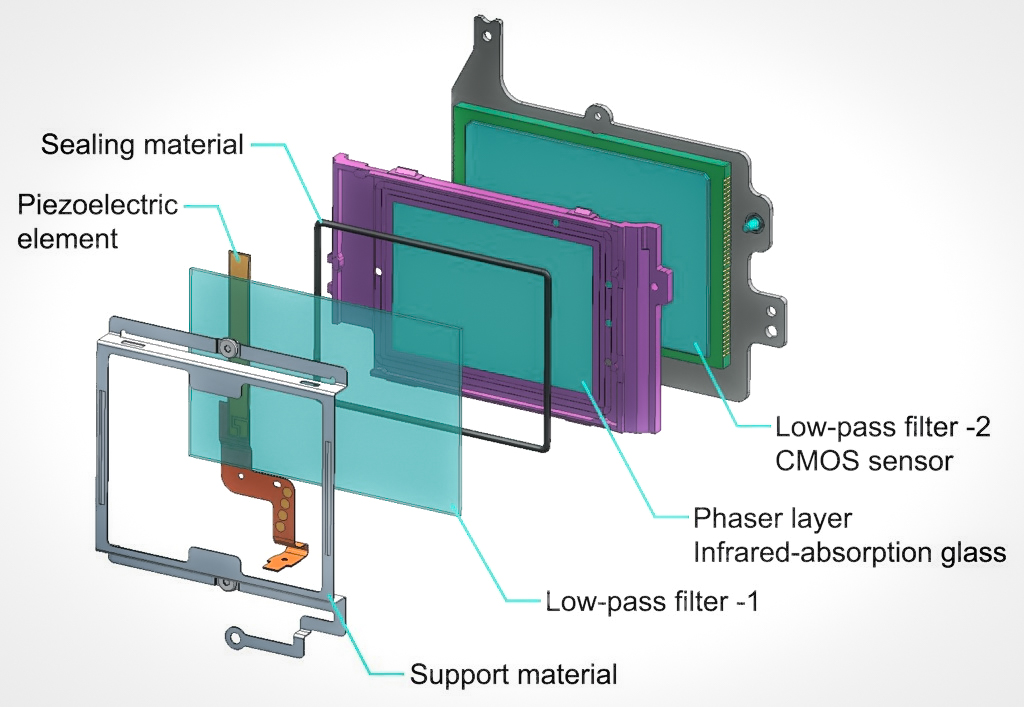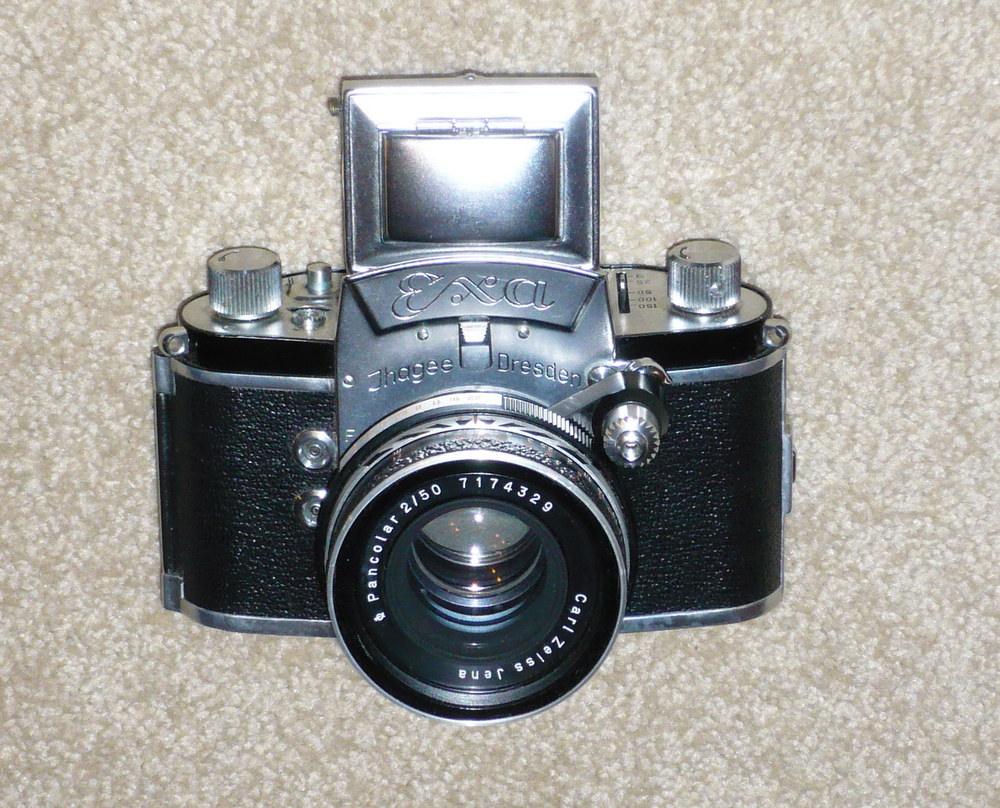|
Polarizing Filter (photography)
A polarizing filter or polarising filter (see spelling differences) is a filter that is often placed in front of a camera lens in photography in order to darken skies, manage reflections, or suppress glare from the surface of lakes or the sea. Since reflections (and sky-light) tend to be at least partially linearly-polarized, a linear polarizer can be used to change the balance of the light in the photograph. The rotational orientation of the filter is adjusted for the preferred artistic effect. For modern cameras, a circular polarizer (CPL) is typically used, which has a linear polarizer that performs the artistic function just described, followed by a quarter-wave plate, which further transforms the linearly polarized light into circularly-polarized light. The circular polarization avoids problems with autofocus and the light-metering sensors in some cameras, which otherwise may not function reliably with only a linear polarizer. Use Light reflected from a non-meta ... [...More Info...] [...Related Items...] OR: [Wikipedia] [Google] [Baidu] |
Circular
*
{{disambiguation ...
Circular may refer to: * The shape of a circle * ''Circular'' (album), a 2006 album by Spanish singer Vega * Circular letter (other), a document addressed to many destinations ** Government circular, a written statement of government policy **Circulaire * Circular reasoning, a type of logical fallacy * Circular reference *Circular Quay, Australia *Circular Park, Armenia See also * Circular DNA (other) * Circular Line (other) * Circularity (other) Circularity may refer to: *Circular definition *Circular economy *Circular reasoning Circular reasoning (, "circle in proving"; also known as circular logic) is a fallacy, logical fallacy in which the reasoner begins with what they are trying ... [...More Info...] [...Related Items...] OR: [Wikipedia] [Google] [Baidu] |
Neutral Density Filter
In photography and optics, a neutral-density filter, or ND filter, is a photographic filter, filter that reduces or modifies the intensity of all wavelengths, or colors, of light equally, giving no changes in hue of color rendition. It can be a colorless (clear) or grey filter, and is denoted by Wratten number 96. The purpose of a standard photographic neutral-density filter is to reduce the amount of light entering the lens. Doing so allows the photographer to select combinations of aperture, exposure time and Film speed, sensor sensitivity that would otherwise produce overexposed pictures. This is done to achieve effects such as a shallower depth of field or motion blur of a subject in a wider range of situations and Atmosphere of Earth, atmospheric conditions. For example, one might wish to photograph a waterfall at a slow shutter speed to create a deliberate motion blur, motion-blur effect. The photographer might determine that to obtain the desired effect, a shutter speed o ... [...More Info...] [...Related Items...] OR: [Wikipedia] [Google] [Baidu] |
Depth Of Field
The depth of field (DOF) is the distance between the nearest and the farthest objects that are in acceptably sharp focus (optics), focus in an image captured with a camera. See also the closely related depth of focus. Factors affecting depth of field For cameras that can only focus on one object distance at a time, depth of field is the distance between the nearest and the farthest objects that are in acceptably sharp focus in the image. "Acceptably sharp focus" is defined using a property called the "circle of confusion". The depth of field can be determined by focal length, distance to subject (object to be imaged), the acceptable circle of confusion size, and aperture. Limitations of depth of field can sometimes be overcome with various techniques and equipment. The approximate depth of field can be given by: \text \approx \frac for a given maximum acceptable circle of confusion , focal length , f-number , and distance to subject . As distance or the size of the acc ... [...More Info...] [...Related Items...] OR: [Wikipedia] [Google] [Baidu] |
Academic Press
Academic Press (AP) is an academic book publisher founded in 1941. It launched a British division in the 1950s. Academic Press was acquired by Harcourt, Brace & World in 1969. Reed Elsevier said in 2000 it would buy Harcourt, a deal completed the next year, after a regulatory review. Thus, Academic Press is now an imprint of Elsevier. Academic Press publishes reference books, serials and online products in the subject areas of: * Communications engineering * Economics * Environmental science * Finance * Food science and nutrition * Geophysics * Life sciences * Mathematics and statistics * Neuroscience * Physical sciences * Psychology Psychology is the scientific study of mind and behavior. Its subject matter includes the behavior of humans and nonhumans, both consciousness, conscious and Unconscious mind, unconscious phenomena, and mental processes such as thoughts, feel ... Well-known products include the '' Methods in Enzymology'' series and encyclopedias such ... [...More Info...] [...Related Items...] OR: [Wikipedia] [Google] [Baidu] |
Anti-aliasing Filter
An anti-aliasing filter (AAF) is a filter used before a signal sampler to restrict the bandwidth of a signal to satisfy the Nyquist–Shannon sampling theorem over the band of interest. Since the theorem states that unambiguous reconstruction of the signal from its samples is possible when the power of frequencies above the Nyquist frequency is zero, a brick wall filter is an idealized but impractical AAF. A practical AAF makes a trade off between reduced bandwidth and increased aliasing. A practical anti-aliasing filter will typically permit some aliasing to occur or attenuate or otherwise distort some in-band frequencies close to the Nyquist limit. For this reason, many practical systems sample higher than would be theoretically required by a perfect AAF in order to ensure that all frequencies of interest can be reconstructed, a practice called oversampling. Optical applications In the case of optical image sampling, as by image sensors in digital cameras, the anti ... [...More Info...] [...Related Items...] OR: [Wikipedia] [Google] [Baidu] |
Beam Splitter
A beam splitter or beamsplitter is an optical instrument, optical device that splits a beam of light into a transmitted and a reflected beam. It is a crucial part of many optical experimental and measurement systems, such as Interferometry, interferometers, also finding widespread application in fibre optic telecommunications. Designs In its most common form, a cube, a beam splitter is made from two triangular glass prism (optics), prisms which are glued together at their base using polyester, epoxy, or urethane-based adhesives. (Before these synthetic resins, natural ones were used, e.g. Canada balsam.) The thickness of the resin layer is adjusted such that (for a certain wavelength) half of the light incident through one "port" (i.e., face of the cube) is reflection (physics), reflected and the other half is transmitted due to Total internal reflection#Frustrated_TIR, FTIR (frustrated total internal reflection). polarizer, Polarizing beam splitters, such as the Wollaston prism ... [...More Info...] [...Related Items...] OR: [Wikipedia] [Google] [Baidu] |
Single-lens Reflex Cameras
In photography, a single-lens reflex camera (SLR) is a type of camera that uses a mirror and prism system to allow photographers to view through the lens and see exactly what will be captured. SLRs became the dominant design for professional and consumer-level cameras throughout the late 20th century, offering interchangeable lenses, through-the-lens (TTL) metering, and precise framing. Originating in the 1930s and popularized in the 1960s and 70s, SLR technology played a crucial role in the evolution of modern photography. Although digital single-lens reflex (DSLR) cameras succeeded film-based models, the rise of Mirrorless camera, mirrorless cameras in the 2010s has led to a decline in SLR use and production. With twin lens reflex and rangefinder cameras, the viewed image could be significantly different from the final image. When the shutter button is pressed on most SLRs, the mirror flips out of the light path and allows light to pass through to the light receptor and the im ... [...More Info...] [...Related Items...] OR: [Wikipedia] [Google] [Baidu] |
Sunstone (medieval)
The sunstone () is a type of mineral attested in several 13th–14th-century written sources in Iceland, one of which describes its use to locate the Sun in a completely overcast sky. Sunstones are also mentioned in the inventories of several churches and one monastery in 14th–15th-century Iceland and Germany. A theory exists that the sunstone had polarizing attributes and was used as a navigational instrument by seafarers in the Viking Age. A stone found in 2002 off Alderney, in the wreck of a 16th-century warship, may lend evidence of the existence of sunstones as navigational devices. Sources One medieval source in Iceland, '' Rauðúlfs þáttr'', mentions the sunstone as a mineral by means of which the sun could be located in an overcast and snowy sky by holding it up and noting where it emitted, reflected or transmitted light (''hvar geislaði úr honum''). Sunstones are also mentioned in ' (13th century) and in church and monastic inventories (14th–15th century) ... [...More Info...] [...Related Items...] OR: [Wikipedia] [Google] [Baidu] |
Scientific American
''Scientific American'', informally abbreviated ''SciAm'' or sometimes ''SA'', is an American popular science magazine. Many scientists, including Albert Einstein and Nikola Tesla, have contributed articles to it, with more than 150 Nobel Prize-winners being featured since its inception. In print since 1845, it is the oldest continuously published magazine in the United States. ''Scientific American'' is owned by Springer Nature, which is a subsidiary of Holtzbrinck Publishing Group. History ''Scientific American'' was founded by inventor and publisher Rufus Porter (painter), Rufus Porter in 1845 as a four-page weekly newspaper. The first issue of the large-format New York City newspaper was released on August 28, 1845. Throughout its early years, much emphasis was placed on reports of what was going on at the United States Patent and Trademark Office, U.S. Patent Office. It also reported on a broad range of inventions including perpetual motion machines, an 1860 devi ... [...More Info...] [...Related Items...] OR: [Wikipedia] [Google] [Baidu] |
Sunglasses
Sunglasses or sun glasses (informally called shades or sunnies; more names Sunglasses#Other names, below) are a form of Eye protection, protective eyewear designed primarily to prevent bright sunlight and high-energy visible light from damaging or discomforting the eyes. They can sometimes also function as a visual aid, as variously termed spectacles or glasses exist, featuring lenses that are colored, polarizer, polarized or darkened. In the early 20th century, they were also known as sun cheaters (cheaters then being an United States, American slang term for glasses). Since the 1930s, sunglasses have been a popular fashion accessory, especially on the beach. The American Optometric Association recommends wearing sunglasses that block ultraviolet radiation (UV) whenever a person is in the sunlight to protect the eyes from UV and blue light, which can cause several #Protection, serious eye problems. Their usage is mandatory immediately after some surgical procedures, such as L ... [...More Info...] [...Related Items...] OR: [Wikipedia] [Google] [Baidu] |
Polarizer
A polarizer or polariser is an optical filter that lets light waves of a specific polarization (waves), polarization pass through while attenuation, blocking light waves of other polarizations. It can filter a beam of light of undefined or mixed polarization into a beam of well-defined polarization, known as polarized light. Polarizers are used in many optics, optical techniques and optical instrument, instruments. Polarizers find applications in photography and liquid crystal display, LCD technology. In photography, a polarizing filter (photography), polarizing filter can be used to filter out reflections. The common types of polarizers are linear polarizers and circular polarizers. Polarizers can also be made for other types of electromagnetic waves besides visible light, such as radio waves, microwaves, and X-rays. Linear polarizers ''Linear polarizers'' can be divided into two general categories: absorptive polarizers, where the unwanted polarization states are absorption ... [...More Info...] [...Related Items...] OR: [Wikipedia] [Google] [Baidu] |







